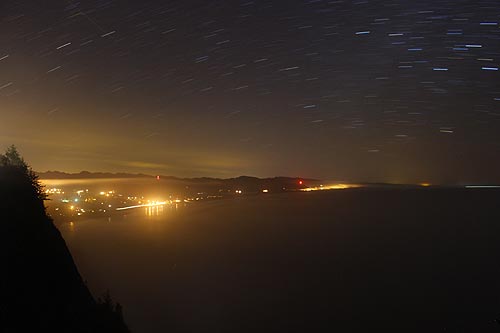Meteor Showers, Planets, King Tides and Rare Supermoon for Oregon, Coast
Published 11/04/2016 at 6:01 AM PDT - Updated 11/04/2016 at 6:03 AM PDT
By Oregon Coast Beach Connection staff

(Manzanita, Oregon) – The night skies above Oregon and the coast will be getting very interesting in the coming week, with a meteor shower right now, some fun planet gazing and an especially bright and close Supermoon next week that will yank the tides incredibly high.
Check out the waxing moon over the next few days dancing around the planets, and even more planetary during the month. Tonight, the moon will be near Mars, according to OMSI's astronomy manager Jim Todd. Then Venus will slowly start gaining in intensity over the month, all the way up to -4.0 to -4.2 as it moves east.
“Saturn is still visible low in the southwest after sunset, but is only some 10 degrees above the horizon 45 minutes after sunset,” Todd said. “As the month progresses it will sink lower and become harder to see. Find this gas giant planet in the southern part of Ophiuchus some 7 degrees up and to the left of Antares in Scorpius.”
Mars will get fainter as it moves through Sagittarius, but it can be seen low above the southern horizon throughout the month.
Meanwhile, look for the Taurid meteor showers, which really started peaking last night. There should be more visible tonight, and possibly Saturday.
“Earth will be passing through debris associated with Comet Encke,” Todd said. “Specks of debris will strike Earth's atmosphere, producing a shower of meteors known as the Taurids. Meteor shower watchers might see a large meteor, or fireball, streaking across the night sky while Taurus is visible above the horizon. At this time of year, Taurus rises in the east at sunset and is nearly overhead by midnight. During the night, you might see anywhere from a drizzle of meteors, or a few fireballs.”
Luckily the moon sets early for awhile. Great places to view this on the Oregon coast include just about any beach little to no light. Stick to broader beaches or dark parking lots, as tides are a tad high these days and venturing onto a blackened beach may be dangerous. Make sure you check out the beach carefully first with a flashlight for the locations of the tide line.
Good dark parking lots include Gleneden Beach State Park, Rodea Point by Depoe Bay, and Yachats Scenic Recreation Area, but some of the best will be high vantage points like Silver Point near Cannon Beach or Neahkahnie Mountain by Manzanita. Broader but darker beaches would be the 12th Ave. access at Seaside (most of the rest of town is fairly bright), parts of Lincoln City, Rockaway Beach and Newport's Nye Beach.
Stay off smaller beaches at night like Gleneden Beach or Oceanside. Do not ever venture onto jetties at night.
Just as the King Tides hit along the Oregon coast – with mammoth tides at nearly ten feet – the full moon of November 14 is a truly super Supermoon. It is not only the closest and brightest super moon of all of 2016, but it is the closest since 1948. Also exceptional: another one this close won't happen for nearly 20 years. The next time the moon is this near to the Earth is 2034.
For the Americas, the moon will actually look fuller on the night of November 13 and through the wee hours. It will still look extra large on the night of the 14th, however. It reaches complete full moon phase at nearly 6 a.m. on the the 14th.
There is yet another Supermoon in December, but it won't be quite as big or as bright. You will want to keep clear of all beaches at night during this high tide phase. Oregon Coast Lodgings for this event - Where to eat - Maps - Virtual Tours





More About Oregon Coast hotels, lodging.....
More About Oregon Coast Restaurants, Dining.....
Cannon Beach Lodging
Nehalem Bay Lodgings
Manzanita Hotels, Lodging
Three Capes Lodging
Pacific City Hotels, Lodging
Lincoln City Lodging
Depoe Bay Lodging
Newport Lodging
Waldport Lodging
Yachats Lodging
Oregon Coast Vacation Rentals
Oregon Coast Lodging Specials
LATEST Related Oregon Coast Articles
Likely just before dawn best hour but peak happens during daylight. Weather
Dark Sky Week is Prime Along Oregon Coast: Where and Where Not to Go
General guide to dark sky viewing from south to north coast. Astronomy
Sizable Price Drop, Deals in Lincoln City During Quiet of April on Central Or...
20 perc off at A1 Vacation Rentals across its roster, including Gleneden Beach. Lincoln City specials
Upcoming S. Oregon Coast Events Include Gem Show, History: Coos Bay, Bandon
May 6 talk at Coos History Museum, Mayfly Fest May 17, Bandon Rock / Gem Show June 7,8
Washington Coast Cleanup on April 19 - Coinciding with Oregon Coast's SOLVE E...
From the Puget Sound to Long Beach, alongside Oregon's cleanup. Washington coast events, Seaside events
Astoria's Riverwalk Gets New Lighting, More N. Oregon Coast Roadwork
Delays coming this summer, but the riverwalk has a new look. Seaside, Cannn Beach
April Gets Even Cheaper Midweek at Depoe Bay, Lincoln City: Oregon Coast Deals
Off-season rates plus more at Keystone Vacation Rentals. Depoe Bay lodging specials, Lincoln City hotel reviews, Newport hotel reviews
Washington Coast Begins Week of Clam Digs, April 12 Through 18
Long Beach, Twin Harbors, Mocrocks and Copalis at different times. Washington coast events
Back to Oregon Coast
Contact Advertise on BeachConnection.net
All Content, unless otherwise attributed, copyright BeachConnection.net Unauthorized use or publication is not permitted













































